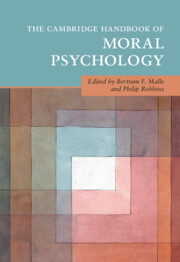Book contents
- The Cambridge Handbook of Moral Psychology
- Cambridge Handbooks in Psychology
- The Cambridge Handbook of Moral Psychology
- Copyright page
- Contents
- Figures
- Tables
- Contributors
- Preface
- 1 Modern Moral Psychology
- Part I Building Blocks
- 2 Moral Character
- 3 Moral Motivation
- 4 Norms: Inference and Interventions
- 5 Moral Dilemmas
- 6 The Moral Domain
- Part II Thinking and Feeling
- Part III Behavior
- Part IV Origins, Development, and Variation
- Part V Applications and Extensions
- Index
- References
4 - Norms: Inference and Interventions
from Part I - Building Blocks
Published online by Cambridge University Press: 20 February 2025
- The Cambridge Handbook of Moral Psychology
- Cambridge Handbooks in Psychology
- The Cambridge Handbook of Moral Psychology
- Copyright page
- Contents
- Figures
- Tables
- Contributors
- Preface
- 1 Modern Moral Psychology
- Part I Building Blocks
- 2 Moral Character
- 3 Moral Motivation
- 4 Norms: Inference and Interventions
- 5 Moral Dilemmas
- 6 The Moral Domain
- Part II Thinking and Feeling
- Part III Behavior
- Part IV Origins, Development, and Variation
- Part V Applications and Extensions
- Index
- References
Summary
This chapter of the handbook examines the foundational role of norms in moral psychology, a topic that has long garnered cross-disciplinary interest from philosophy to biology, from anthropology to computer science. The authors touch briefly on the debates over potentially different types of norm (e.g., conventional, social, moral, legal) and maintain that social and moral norms, in particular, are difficult to separate unless one adopts a specific theoretical position. The authors’ treatment centers on a core feature of most or all social and moral norms: that people, in complying or not complying with norms, are sensitive to other community members’ norm-relevant beliefs and attitudes. By recognizing this sensitivity, scientists can, first, gain a better scientific understanding of norm inference, the complex processes by which people learn which norms apply to a given setting and how strong the norms are; and second, they can better diagnose whether (and how strongly) a given norm exists in a community. All these insights pave the way for potential interventions on people’s beliefs about the community’s norms, which are easier to change than individual moral convictions.
- Type
- Chapter
- Information
- The Cambridge Handbook of Moral Psychology , pp. 78 - 100Publisher: Cambridge University PressPrint publication year: 2025

